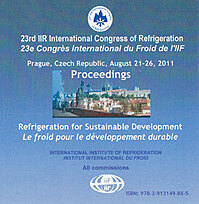
Document IIF
Étude d'un éjecteur diphasique utilisé comme compresseur pour la deuxième étape de compression des systèmes frigorifiques.
Investigation of a two-phase ejector as a second-step compressor for refrigeration systems.
Numéro : pap. ID: 678
Auteurs : SMIERCIEW K., BUTRYMOWICZ D., KARWACKI J., et al.
Résumé
The paper describes the investigation of the refrigeration vapour compression cycle equipped with the two-phase ejector used as a second step compression device. In the described cycle, the compressor discharge pressure is lower than the condensation pressure. The additional compression is provided by the ejector. This approach may lead to reduce the power consumption of the compressor and therefore improving the efficiency of the compression cycle. A testing stand has been build. The experimental investigations have been carried out with refrigerant R507. The experiments covered two geometries of the ejector equipped with the sharp-edge motive nozzles of various diameters. The relative compression ratio defined as the ratio of the compression produced by the ejector to motive pressure difference in the reported experiments was up to 0.20 and mass entrainment ratio was up to 0.30. It was shown that the compression ratio and entrainment ratio strongly depend on the operation parameters of the system.
Documents disponibles
Format PDF
Pages : 8 p.
Disponible
Prix public
20 €
Prix membre*
Gratuit
* meilleur tarif applicable selon le type d'adhésion (voir le détail des avantages des adhésions individuelles et collectives)
Détails
- Titre original : Investigation of a two-phase ejector as a second-step compressor for refrigeration systems.
- Identifiant de la fiche : 30002125
- Langues : Anglais
- Source : Proceedings of the 23rd IIR International Congress of Refrigeration: Prague, Czech Republic, August 21-26, 2011. Overarching theme: Refrigeration for Sustainable Development.
- Date d'édition : 21/08/2011
Liens
Voir d'autres communications du même compte rendu (569)
Voir le compte rendu de la conférence
-
Review on ejector efficiencies in various eject...
- Auteurs : LIU F.
- Date : 14/07/2014
- Langues : Anglais
- Source : 2014 Purdue Conferences. 15th International Refrigeration and Air-Conditioning Conference at Purdue.
- Formats : PDF
Voir la fiche
-
Experimental study on performance of two-throat...
- Auteurs : REN L., GUO X., LI T., et al.
- Date : 14/07/2014
- Langues : Anglais
- Source : 2014 Purdue Conferences. 15th International Refrigeration and Air-Conditioning Conference at Purdue.
- Formats : PDF
Voir la fiche
-
Assessment of maximum allowable discharge press...
- Auteurs : JAKONCZUK P., SMIERCIEW K., BUTRYMOWICZ D., GAGAN J., MANIA T.
- Date : 21/08/2023
- Langues : Anglais
- Source : Proceedings of the 26th IIR International Congress of Refrigeration: Paris , France, August 21-25, 2023.
- Formats : PDF
Voir la fiche
-
Transcritical R744 multi-temperature refrigerat...
- Auteurs : LAWRENCE N., ELBEL S., HRNJAK P.
- Date : 26/08/2020
- Langues : Anglais
- Source : 6th IIR International Conference on Sustainability and the Cold Chain. Proceedings: Nantes, France, August 26-28 2020
- Formats : PDF
Voir la fiche
-
Theoretical analysis of the optimal ejector ope...
- Auteurs : METSUE A., NESREDDINE H., PONCET S., BARTOSIEWICZ Y.
- Date : 08/2024
- Langues : Anglais
- Source : 16th IIR-Gustav Lorentzen Conference on Natural Refrigerants (GL2024). Proceedings. University of Maryland, College Park, Maryland, USA, August 11-14 2024
- Formats : PDF
Voir la fiche
